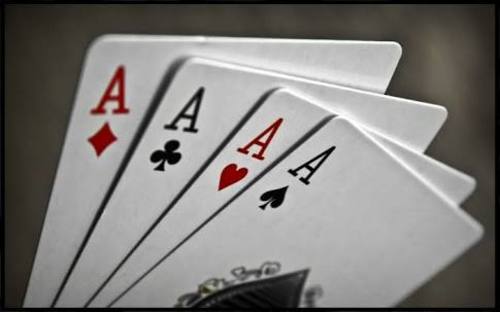Will the lost card affect?
 One of a pack of 52 cards has been lost. From the remainder of the pack two cards are drawn and are found to be spades. Find the chance that the missing card is a spade.
One of a pack of 52 cards has been lost. From the remainder of the pack two cards are drawn and are found to be spades. Find the chance that the missing card is a spade.
The answer is 0.22.
This section requires Javascript.
You are seeing this because something didn't load right. We suggest you, (a) try
refreshing the page, (b) enabling javascript if it is disabled on your browser and,
finally, (c)
loading the
non-javascript version of this page
. We're sorry about the hassle.
2 solutions
Interesting! I went with Bayes' Theorem on this one:
5 1 ⋅ 5 0 1 2 ⋅ 1 1 + 5 1 ⋅ 5 0 1 3 ⋅ 1 2 + 5 1 ⋅ 5 0 1 3 ⋅ 1 2 + 5 1 ⋅ 5 0 1 3 ⋅ 1 2 5 1 ⋅ 5 0 1 2 ⋅ 1 1 = 0 . 2 2
Each additional denominator term is for each other suit that could be missing and the double spade outcome occurred.
After the two spades are drawn, we have 49 cards in the pack and 1 missing. In these 50 cards, 11 are spades. Then, the chance of the missing card being a spade is 11/50.
Let’s pick 3 cards from a standard 5 2 card deck. What’s the probability that the 2 nd and 3 rd cards drawn are both spades?
5 2 ⋅ 5 1 ⋅ 5 0 3 9 ⋅ 1 3 ⋅ 1 2 + 5 2 ⋅ 5 1 ⋅ 5 0 1 3 ⋅ 1 2 ⋅ 1 1 = 1 7 1
What’s the probability that all 3 cards picked are spades?
5 2 ⋅ 5 1 ⋅ 5 0 1 3 ⋅ 1 2 ⋅ 1 1 = 8 5 0 1 1
Hence, the probability that the “missing card” was a spade is that fraction
1 7 1 8 5 0 1 1 = 5 0 1 1 = 0 . 2 2 0
Without having drawn the 2 nd and 3 rd cards, the probability would have been 0 . 2 5 0 . After drawing the two cards and discovering both to be spades reduces this to 0 . 2 2 0 .